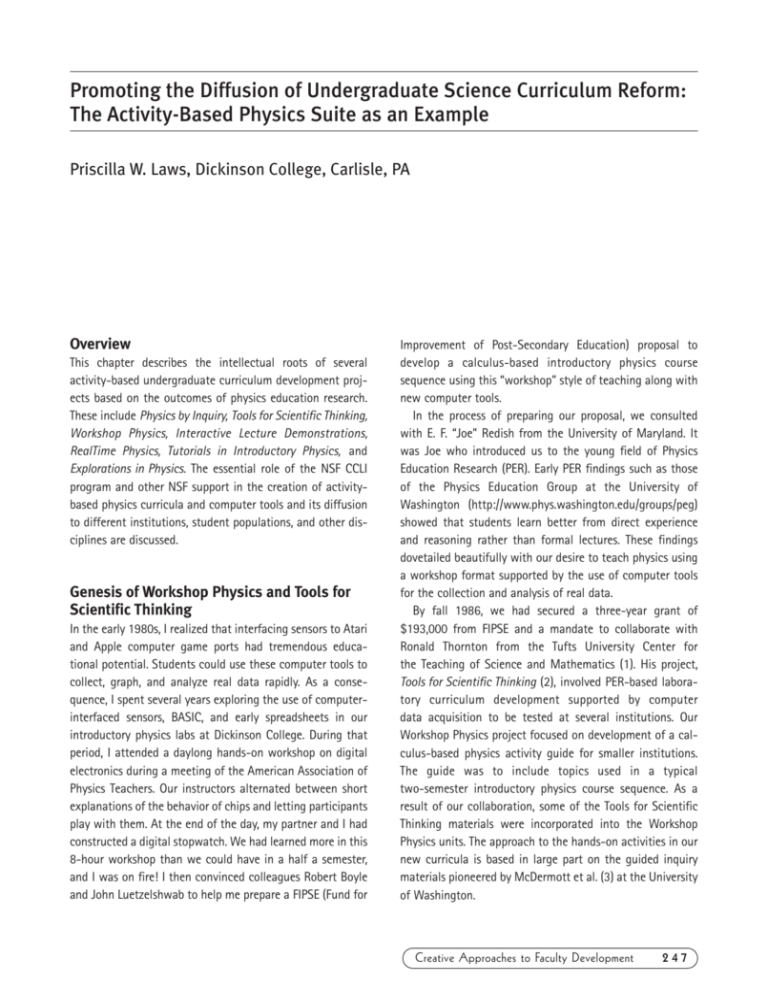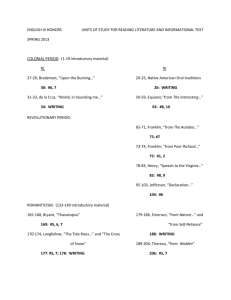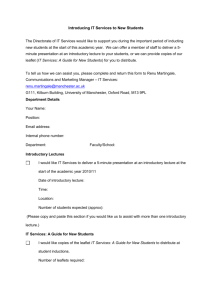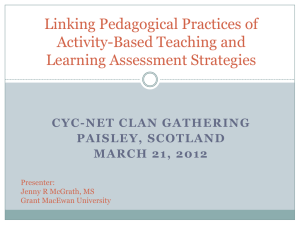The Activity-Based Physics Suite as an Example
advertisement

Promoting the Diffusion of Undergraduate Science Curriculum Reform: The Activity-Based Physics Suite as an Example Priscilla W. Laws, Dickinson College, Carlisle, PA Overview This chapter describes the intellectual roots of several activity-based undergraduate curriculum development projects based on the outcomes of physics education research. These include Physics by Inquiry, Tools for Scientific Thinking, Workshop Physics, Interactive Lecture Demonstrations, RealTime Physics, Tutorials in Introductory Physics, and Explorations in Physics. The essential role of the NSF CCLI program and other NSF support in the creation of activitybased physics curricula and computer tools and its diffusion to different institutions, student populations, and other disciplines are discussed. Genesis of Workshop Physics and Tools for Scientific Thinking In the early 1980s, I realized that interfacing sensors to Atari and Apple computer game ports had tremendous educational potential. Students could use these computer tools to collect, graph, and analyze real data rapidly. As a consequence, I spent several years exploring the use of computerinterfaced sensors, BASIC, and early spreadsheets in our introductory physics labs at Dickinson College. During that period, I attended a daylong hands-on workshop on digital electronics during a meeting of the American Association of Physics Teachers. Our instructors alternated between short explanations of the behavior of chips and letting participants play with them. At the end of the day, my partner and I had constructed a digital stopwatch. We had learned more in this 8-hour workshop than we could have in a half a semester, and I was on fire! I then convinced colleagues Robert Boyle and John Luetzelshwab to help me prepare a FIPSE (Fund for Improvement of Post-Secondary Education) proposal to develop a calculus-based introductory physics course sequence using this “workshop” style of teaching along with new computer tools. In the process of preparing our proposal, we consulted with E. F. “Joe” Redish from the University of Maryland. It was Joe who introduced us to the young field of Physics Education Research (PER). Early PER findings such as those of the Physics Education Group at the University of Washington (http://www.phys.washington.edu/groups/peg) showed that students learn better from direct experience and reasoning rather than formal lectures. These findings dovetailed beautifully with our desire to teach physics using a workshop format supported by the use of computer tools for the collection and analysis of real data. By fall 1986, we had secured a three-year grant of $193,000 from FIPSE and a mandate to collaborate with Ronald Thornton from the Tufts University Center for the Teaching of Science and Mathematics (1). His project, Tools for Scientific Thinking (2), involved PER-based laboratory curriculum development supported by computer data acquisition to be tested at several institutions. Our Workshop Physics project focused on development of a calculus-based physics activity guide for smaller institutions. The guide was to include topics used in a typical two-semester introductory physics course sequence. As a result of our collaboration, some of the Tools for Scientific Thinking materials were incorporated into the Workshop Physics units. The approach to the hands-on activities in our new curricula is based in large part on the guided inquiry materials pioneered by McDermott et al. (3) at the University of Washington. Creative Approaches to Faculty Development 247 By 1989, as the Dickinson College and Tufts University FIPSE grants were winding down, Ron and a new collaborator, David Sokoloff from the University of Oregon, had created and tested a series of Tools for Scientific Thinking laboratory activities that could be used to replace some but not all of the laboratory sessions in traditional introductory physics labs. In addition, several colleagues at Dickinson College, including Robert Boyle and Ken Laws, helped me complete a preliminary version of the 28-unit Workshop Physics Activity Guide eventually published by Wiley in 1997 (4). We found a need for better tools for data collection and analysis. This led to the creation of a new interface, known as the Universal Laboratory Interface (ULI). The ULI specifications were developed jointly by Ron Thornton (Tufts University), Robert Tinker (Technical Education Research Centers), and myself. Ron Budworth of the Transpacific Computer Company took care of the design and manufacturing. At the same time, computer software and new sensors for use with the ULI was being developed at Tufts University under Ron Thornton’s direction. By 1990, Vernier Software and Technology began commercial distribution of the ULI interface and software. The Impetus to Create Additional ActivityBased Physics Materials We found that three years was not enough time to polish the curricular materials, complete research on their effectiveness, and disseminate our work. Ron, David, and I began giving workshops at the semi-annual meetings of the American Association of Physics Teachers. By 1990, we secured a collaborative grant from FIPSE and an NSF Undergraduate Faculty Enhancement (UFE) grant. These grants allowed us to continue curriculum development and assessment. As part of the Workshop Physics project, we were able to redesign the laboratory space (http://physics.dickinson.edu/∼7Ewp_web/wp_lab&equip. html) and begin the development of kinesthetic apparatus and activities in collaboration with Hans Pfister, a new Dickinson College faculty member (Figure 1). In addition, we began disseminating our methods and materials by means of summer workshops. Although our growing dissemination efforts were critical to garnering adopters, the feedback we got from our workshop participants and others indicated that we needed a more flexible and comprehensive set of activity-based curricular materials and computer tools. Thus, in the early 1990s, we began work on Interactive Lecture Demonstrations (ILDs) and the RealTime Physics (RTP) laboratory modules, a comprehensive set of activities designed to replace traditional labs. Pat Cooney from Millersville University helped us develop spreadsheet-based analytic mathematical modeling to the Workshop Physics (WP) curriculum (http://muweb.millersville.edu/~pjcooney). He also helped with the design of WPTools—a set of Visual BASIC macros that enhance Excel’s graphing capabilities (http://physics. dickinson.edu/~7Ewp_web/wp_resources/wp_downloads.ht ml). These new developments were supported by UFE and Course and Curriculum Development (CCD) grants awarded to Dickinson College, Tufts University, and the University of Oregon. Figure 1. A: Activity-based Workshop Physics classroom design. B: Students doing kinesthetic activities. 248 Creative Approaches to Faculty Development In 1995, we began collaborating with Joe Redish and his graduate students in the newly formed University of Maryland Physics Education Research Group (http://www.physics.umd.edu/perg). The Maryland Group served as evaluators for projects funded by FIPSE to disseminate WP and RTP Activity Guides and teaching methods. The new collaboration greatly extended the level of our physics education research, and we began using the outcomes of assessments to refine the WP Activity Guide. At about the same time, Wiley had agreed to help us prepare the WP and RTP materials for commercial publication. When we began working closely with adopters as part of our dissemination efforts, we realized that, in spite of our continued improvements and extensions of our activitybased materials, several implementation barriers still inhibited widespread adoption of our innovations in many educational environments. Fortunately, by 1995, we were awarded a major four-year NSF CCD grant that allowed us to continue our work. The fact that we as principal investigators came from five very different universities and colleges (5) and worked closely with other institutions enabled us to identify many implementation barriers. A delightful but unanticipated outcome of our Activity-Based Physics NSF CCD project was that it catalyzed the organization of our materials into something we now call the Activity-Based Physics Suite. suite that are appropriate in their instructional environments. By 1998, Karen Cummings, who was directing the Studio Physics Project at Rensselaer Polytechnic Institute, had joined the college and university contingent of the ActivityBased Physics Group to help develop the textbook portion of the suite as a supplement to our activity-based materials. Even with Karen on board, reworking our materials for inclusion in the suite took the better part of four years. The Physics Suite, just published by John Wiley & Sons, now includes the Interactive Lecture Demonstration Series (6) designed primarily for use in lecture sessions. Other suite materials can be used in laboratory settings including The Workshop Physics Activity Guide (7), the RealTime Physics laboratory modules (8), and Physics by Inquiry (9). Additional Problems Narrative Understanding Physics Laboratories Activity-Based Physics Suite In 1997 and 1998, Wiley’s physics editor, Stuart Johnson, and our Activity-Based Physics Group began discussing the feasibility of integrating a broad array of physics education research-based curricular materials. Our major goal for developing the suite concept was to reduce implementation barriers. Thus, the idea of the suite is to facilitate implementation by organizing materials so instructors could either 1) use many of them at the same time or 2) integrate one or more elements with the materials they are already using. The suite was not conceived as requiring a radical change to the traditional approach to introductory physics teaching right away. Instead, we hoped to provide elements that are both familiar and improved as a result of what has been learned from physics education research and as a result of new developments in educational technology. So instructors can choose to incrementally adopt individual elements of the Touchstone examples Reading exercises Problem Collections RealTime physics Tools for Scientific Thinking Action Research Kit Concept surveys Attitude surveys ILDs Instructor's Guide Teaching Physics with the Physics Suite Tutorials Workshops Tutorials in Introductory Physics Workshop Physics Tools ABP Tutorials WP spreadsheet tools Explorations in Physics Videopoint Computer data acquisition tools Figure 2. Elements of the the Activity-Based Physics (ABP) Suite. Creative Approaches to Faculty Development 249 elements in the collection are suitable for use in recitation sessions such as the University of Washington Tutorials in Introductory Physics (available from Prentice Hall) (10) and a set of more quantitative Activity-Based Physics tutorials (11) developed at the University of Maryland. A textbook entitled Understanding Physics has been developed for use with the other suite materials (12). The Activity-Based Physics Suite is rounded out with a collection of thinking problems, developed at the University of Maryland. A schematic showing the relationship between elements is shown in Figure 2. A more detailed description of the physics suite elements follows. Teaching Physics with the Physics Suite by Edward F. Redish (University of Maryland) This book is not only the “Instructor’s Manual” for Understanding Physics, but it is also a book for anyone who is interested in learning about recent developments in physics education. It is a handbook with a variety of tools for improving both teaching and learning of physics—from new kinds of homework and exam problems, to surveys for figuring out what has happened in class, to tools for taking and analyzing data using computers and video. The book comes with a Resource CD containing 14 conceptual and 3 attitude surveys and more than 250 thinking problems covering all areas of introductory physics, resource materials from commercial vendors on use of computerized data acquisition and video, and a variety of other useful reference materials. (Instructors can obtain a complimentary copy of the book and Resource CD from John Wiley & Sons.) RealTime Physics by David Sokoloff (University of Oregon), Ron Thornton (Tufts University), and Priscilla Laws (Dickinson College) RealTime Physics is a set of laboratory materials that uses computer-assisted data acquisition to help students build concepts, learn representation translation, and develop an understanding of the empirical base of physics knowledge. There are four modules in the collection: Module 1: Mechanics (12 labs), Module 2: Heat and Thermodynamics (6 labs), Module 3: Electric Circuits (8 labs), and Module 4: Light and Optics (in production) (available both in print and in electronic form from John Wiley & Sons). 250 Creative Approaches to Faculty Development Interactive Lecture Demonstrations by David Sokoloff (University of Oregon) and Ron Thornton (Tufts University) ILDs are worksheet-based guided demonstrations designed to focus on fundamental principles and address specific naive conceptions. The demonstrations use computerassisted data acquisition tools to collect and display highquality data in real time. Each ILD sequence is designed for delivery in a single lecture period. The demonstrations help students build concepts through a series of instructor-led steps involving prediction, discussions with peers, viewing the demonstration, and reflecting on its outcome. The ILD collection includes sequences in mechanics, thermodynamics, electricity, optics, and more. (A set of mechanics ILDs is currently available from Vernier Software and Hardware. A more complete set of modules is currently in production at John Wiley & Sons. For more information, contact David Sokoloff at sokoloff@oregon.uoregon.edu.) Workshop Physics by Priscilla Laws (Dickinson College) Workshop Physics consists of a four-part activity guide designed for use in calculus-based introductory physics courses. Workshop Physics courses are designed to replace traditional lecture and laboratory sessions. Students use computer tools for data acquisition, visualization, analysis, and modeling. The tools include computer-assisted data acquisition software and hardware, digital video capture and analysis software, and spreadsheet software for analytic mathematical modeling. Modules include Classical Mechanics (Modules 1 and 2); Heat, Temperature, and Nuclear Physics (Module 3); and Electricity and Magnetism (Module 4) (available both in print from John Wiley & Sons and in electronic form on The Physics Suite CD). Tutorials in Introductory Physics by Lillian C. McDermott, Peter S. Shaffer, and the Physics Education Group at the University of Washington These tutorials consist of a set of worksheets designed to supplement instruction by lectures and textbook in standard introductory physics courses. Each tutorial is designed for use in a one-hour class session in a space where students can work in small groups using simple inexpensive apparatus. The emphasis in the tutorials is on helping students deepen their understanding of critical concepts and develop scientific reasoning skills. There are tutorials on mechanics, electricity and magnetism, waves, optics, and other selected topics (available in print from Prentice Hall, Upper Saddle River, NJ). Physics by Inquiry by Lillian C. McDermott and the Physics Education Group at the University of Washington This self-contained curriculum consists of a set of laboratory-based modules that emphasize the development of fundamental concepts and scientific reasoning skills. Beginning with their observations, students construct a coherent conceptual framework through guided inquiry. Only simple inexpensive apparatus and supplies are required. Developed primarily for the preparation of precollege teachers, the modules have also proved effective in courses for liberal arts students and for underprepared students. The amount of material is sufficient for two years of academic study (available in print from John Wiley & Sons). Understanding Physics This new text (based on the 6th edition of Halliday, Resnick, and Walker’s Fundamentals of Physics) is designed for compatibility with other Activity-Based Physics Suite elements. Authors Karen Cummings, Priscilla Laws, E. F. Redish, and Pat Cooney have incorporated some new features including • stronger storyline to link topics throughout text • more emphasis on the observational basis of physics, including sample data acquired in introductory physics laboratories • narratives rewritten to address learning difficulties • incorporation of active learning opportunities • use of the New Mechanics Sequence • introduction of more systematic notation conventions. The Activity-Based Physics Tutorials by Edward F. Redish and the University of Maryland Physics Education Research Group These tutorials, like those developed at the University of Washington, consist of a set of worksheets developed to supplement lectures and textbook work in standard introductory physics courses. But, these tutorials integrate the computer software and hardware tools used in other suite elements including computer data acquisition, digital video analysis, simulations, and spreadsheet analysis. Although these tutorials include a range of classic physics topics, they also include additional topics in modern physics. (This is only available electronically from the University of Maryland Physics Education Research Group website above. A CD is being prepared by John Wiley & Sons for distribution of the Activity-Based Physics Tutorials as part of the Physics Suite CD.) Creative Approaches to Faculty Development 251 REFERENCES 7. Laws, P. 2004. The Workshop Physics Activity Guide. 2nd ed. New York: Wiley. 1. Workshop Physics: Replacing Lectures with Real Experience. FIPSE #G008642146, June 1986 to September 1989 8. Sokoloff, D. R. 1999. RealTime Physics: Modules 1–2. New York: Wiley. 2. Tools for Scientific Thinking: Microcomputer Based Laboratories for College Physics. FIPSE, June 1986 to September 1989 9. McDermott, L. C., P. S. Shaffer, M. L. Rosenquist, and the Physics Education Group at the University of Washington. 1996. Physics by Inquiry. 1st ed. New York: Wiley. 3. McDermott, L. C., and the Physics Education Group at the University of Washington. 1996. Physics by Inquiry. New York: Wiley. 10. McDermott, L. C., P. S. Shaffer, and the Physics Education Group at the University of Washington. 2002. Tutorials in Introductory Physics. 1st ed. Upper Saddle River, NJ: Prentice Hall. 4. Laws, P. W. 1997, 2004. The Workshop Physics Activity Guide: Modules 1–4. New York: Wiley. 5. Activity-Based Physics: Curricula, Computer Tools, and Apparatus for Introductory Physics Courses. DUE 9455561, 1 May 1995 to 31 July 1999 6. Sokoloff, D. R., and R. K. Thornton. 1997. Using interactive lecture demonstrations to create an active learning environment. The Physics Teacher 35: 340–347. 252 Creative Approaches to Faculty Development 11. Steinberg, R. N., M. C. Wittmann, and E. F. Redish. 1997. Mathematical tutorials in introductory physics. In The Changing Role of Physics Departments in Modern Universities. E. F. Redish, J. S. Rigden, Eds. 1075–1092. AIP Conference Proceedings 399. Woodbury, NY: AIP. 12. Cummings, K., P. Laws, E. F. Redish, and P. J. Cooney. 2004. Understanding Physics. New York: Wiley.




